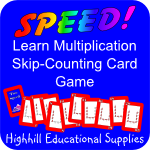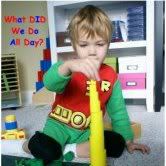Just a Few Benefits of Playing Games
- Good Sportsmanship
- Cooperation
- Turn-Taking
- Rules
- Encourages Family Togetherness
- Reinforces Concepts, Skills, and Mathematical Thinking
- Builds Character
- Addresses Fairness
- Builds Higher Order Thinking and Logical Skills
- Helps Set Goals and Planning Ahead
- and ... most importantly having FUN!
My Approach to Game Rules
I always teach Alyssa the rules before the game and make sure she understands how to play. I figure once she knows how to play the real game we can get creative and make our own versions at a later time to make it more interesting or challenging. I also play a few games with her in order to act as a guide. I help her make decisions and model my thought processes on my turn. I will often ask her to help me figure out what to do, so that I can learn how she thinks and see if she is confused with any of the rules or concepts. After this learning process, she plays with us making her own decisions and choices. I never purposely let her win. I want her to know that she won the game because of her efforts and thinking. I also feel it is important for children to know that they won't always win. I want Alyssa to learn how to lose gracefully. Another thing I have been known to do is teach the game in incremental steps.
Math Game Treasures We Love
I want to give you a glimpse of a few of our educational math games. Most of our games are packed and in storage due to lack of space in the apartment. I often search high and low for high quality, educational games that my daughter will like and find interesting. As we all know, all children are different and what we enjoy playing your children may or may not find enjoyable. I will say these math games are worth at least considering. Playing math games is a fun-filled method for introducing, reinforcing, and maintaining skills learned throughout the year. I have been buying educational games for Alyssa for years. She doesn't know they are educational and is never bored playing them. She just thinks, "Yah ... it is game night." Last night, we were visiting her grandparents and she wanted badly to play RACKO! She asked her grandparents over and over again. Unfortunately, papa is the game player and he was helping daddy construct our house plans. Don't worry ... I played a game or two with her that night.
Here are five of our unpacked math games that I can share with you today.
Roll It Tic-Tac-Toe
This is not your ordinary tic-tac-toe game! This is our number one favorite math game. Alyssa received an Amazon gift card for Christmas last year and we used it to purchase this game for only $9.99 with free shipping. It is so worth the price. We get a huge kick out of this game! I HIGHLY recommend it. The objective is to get the most Tic-Tac-Toes and GRAND Tic-Tac-Toes on nine different grids. You pick a set of colored chips. The CRAZY thing about this game is that up to six people can play and all players use the same board. It can be overwhelmingly fun and intense. You roll two die, add the numbers together (that's what I am talking about), and cover the sum on any "one" of the nine grids with your colored chip. You also obviously try to block others from getting a tic-tac-toe (great for thinking skills). You do not stop the game when one person gets a tic-tac-toe you continue playing until board is covered or there are no other plays. A GRAND Tic-Tac-Toe occurs when you have three adjacent grids in a row either vertically, horizontally, or diagonally. The addition practice continues when you add the points for each player. You get one point for each colored chip, 3 points for each tic-tac-toe, and 5 for each GRAND Tic-Tac-Toe. The company even has a way to score for a tie breaker. When we first played this game, we didn't have Alyssa add up everything. We let her count her single chips and watch us add up the scores. However, I will now challenge her since she can count by 3's, 5's, and has been doing 2nd grade addition through Dreambox. I will provide a 100 chart or base ten block as manipulatives if needed. You can also adapt the game by using fewer grids although we use the entire board. This is an absolutely wonderful game to reinforce addition skills, thinking skills, and number recognition.
 |
| Intense thinking ... I tried not to rush her thought process. She won this game! |
 |
| She always wants to be in the picture. |
I found this fast action game at a Friends of the Library book sale for $2.00. The object of the game is to score the most cards by the end of the game. In the beginning, we did not time Alyssa. As her addition skills improved and she learned how to play the game, we brought out the timer. That's when the wild fun began! You have around 30 seconds to roll three dice, collect cards, redraw 5 cards for your row, and end your turn. You can roll the three dice as many times as you want within your time limit. You can collect cards that either represent the number on the die or one that adds up to the exact number. This will make more sense after you see the directions and example provided. You also can't take a card that has been used and is represented by a number on a die. For example, if you roll a 3, 6, and 2. Say you add 3+6 to get 9; you can't use the three or the six again. The game makers throw in another challenge. As mentioned above, you are responsible for stopping your turn before the timer ends. However, the sand timer is hidden from your view. If you stop it before the timer yells, "Stop" then you get all the cards you collected. You lose all the cards on that turn if you don't stop in time. They also throw in a doubles card which makes things more interesting. The doubles card gives you two more playing options. You will have to go purchase the game to find out what else you can do. One point is given for each card collected. Three turns for ALL players equals one scoring frame. A game ends once 3 scoring frames have been filled. To make it easier for younger children learning the game, you can explain that this time they will be allowed to see the timer. In the future, they will not be allowed to see it. You may even choose not to bring out the timer. You could also purchase a different timer allowing younger children more time to play until they improve. I have seen 1, 2, and 3 minute timers at teacher stores. At first, we did not score the game to make things less complicated. Players can work at their level whether it be recognizing numbers, adding two numbers, or adding all three dice. This game reinforces addition skills and recognition of numbers. They have an advanced version for those of you up to the challenge. Are you?
| Considering all of her options |
Double Shutter Shut the Super Box
This game originated in France during the 17th century. Double Shutter will challenge you to flip as many tiles possible on your turn. The self-contained game is intended for up to four players ages 8 and up. The objective is to shut the super box (all the tiles) or to have the lowest remaining tile total. You begin by rolling the die and adding up the dots to shut tiles. The sum of the tiles must match the dot total in any combination. You decide the best combination to shut the two rows of nine tiles. Your turn continues until you can't shut anymore tiles. The row in the back can't be flipped down until the tile in front row is shut. Each round ends when you can't beat the lowest tile score. The player with the lowest total tile score wins the round. One round is complete when each player attempts to beat the lowest score. Your score is determined by the numbers on the tiles left up. Be careful because the first row is worth double the points. You can play 3-10 rounds. You can even play this game alone. The solitaire version allows you to improve your score on each attempt. In the beginning, we played this game without keeping score. I was content with the fact that Alyssa was learning about numbers, number combinations, and practicing addition facts.
Do you wanna play Double Shutter Box online? Click here to give it a try. Be aware that there are technological quirks at times during the game unless it is just my computer.
Jumpin' Chips Addition
We found this game 50% off at a teacher store which was going out of business. Jumpin' Chips Addition is an exciting way to practice and master addition facts up to 24 (through 12+12). You can choose from five different game versions. We usually play Games 1, 2 and 4. The chips are color-coded for each addition table and self-correcting. The objective of the game depends on the version you are playing. The goal may be to obtain the most chips or number of points. One version is played similar to the rules for checkers. Another version allows you to choose a few addition tables at a time. This is a great way to differentiate learning. The centered star square is not covered and chips are randomly placed on the board. The player must strategically think and create a plan to jump over as many chips as possible while solving addition equations accurately and quickly in order to win the game. The player checks the answer which can be found on the back of the chip. This game is recommended for 1-4 players ages 6 and up. The main rule to keep in mind is that a player must jump in a straight line over another chip moving to an empty square before making the next jump. We practice skip counting by 1', 2's, 3's, and 4's and addition when counting points during Game 2. As players win chips, they stack them according to their color. Each color represents a certain number of points.
Jumpin' Chips Addition
We found this game 50% off at a teacher store which was going out of business. Jumpin' Chips Addition is an exciting way to practice and master addition facts up to 24 (through 12+12). You can choose from five different game versions. We usually play Games 1, 2 and 4. The chips are color-coded for each addition table and self-correcting. The objective of the game depends on the version you are playing. The goal may be to obtain the most chips or number of points. One version is played similar to the rules for checkers. Another version allows you to choose a few addition tables at a time. This is a great way to differentiate learning. The centered star square is not covered and chips are randomly placed on the board. The player must strategically think and create a plan to jump over as many chips as possible while solving addition equations accurately and quickly in order to win the game. The player checks the answer which can be found on the back of the chip. This game is recommended for 1-4 players ages 6 and up. The main rule to keep in mind is that a player must jump in a straight line over another chip moving to an empty square before making the next jump. We practice skip counting by 1', 2's, 3's, and 4's and addition when counting points during Game 2. As players win chips, they stack them according to their color. Each color represents a certain number of points.
| So Serious ... Alyssa tapping her fingers on the table considering her next move. |
I usually purchase many of my games on Amazon or through other online stores. I also shop at Target, Walmart, Toysrus, and of course Lakeshore Learning. Games are especially great for visual, hands-on, active learners. Games are appropriate for children of all ages or grade levels. Remember that you can always adapt or modify a game to what you are learning and for the child's age or abilities. Playing games together has given us many lasting, fun-filled memories. I feel it is important to get your children thinking mathematically through the use of games. Well, these are a few of the math games that I can share with you today. So, now I ask you ...
Have you played a game with your child today???
Please visit the Blog Cruise here to read what other bloggers have to say about homeschooling with games. The link and button will be active on Tuesday, October 2nd.
























I like this idea, but my little ones don't have the patience for many math games. The get board with addition and subtraction, just because they aren't quick at it, takes to much effort and therefore, isn't fun for them. I'd like to try Rack-o out on them though. Maybe that would be a step into roll-tic-tac-toe.
ReplyDelete